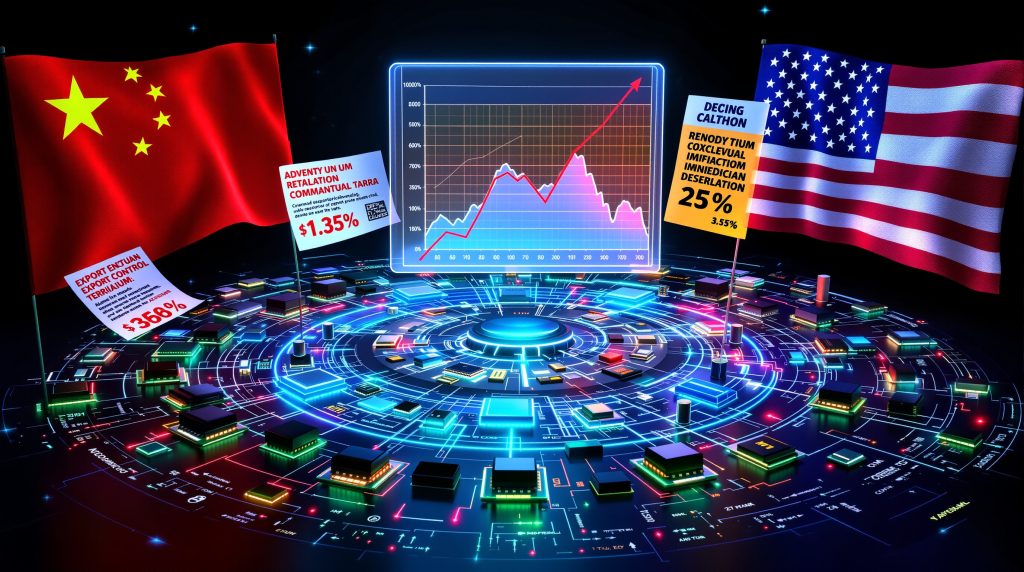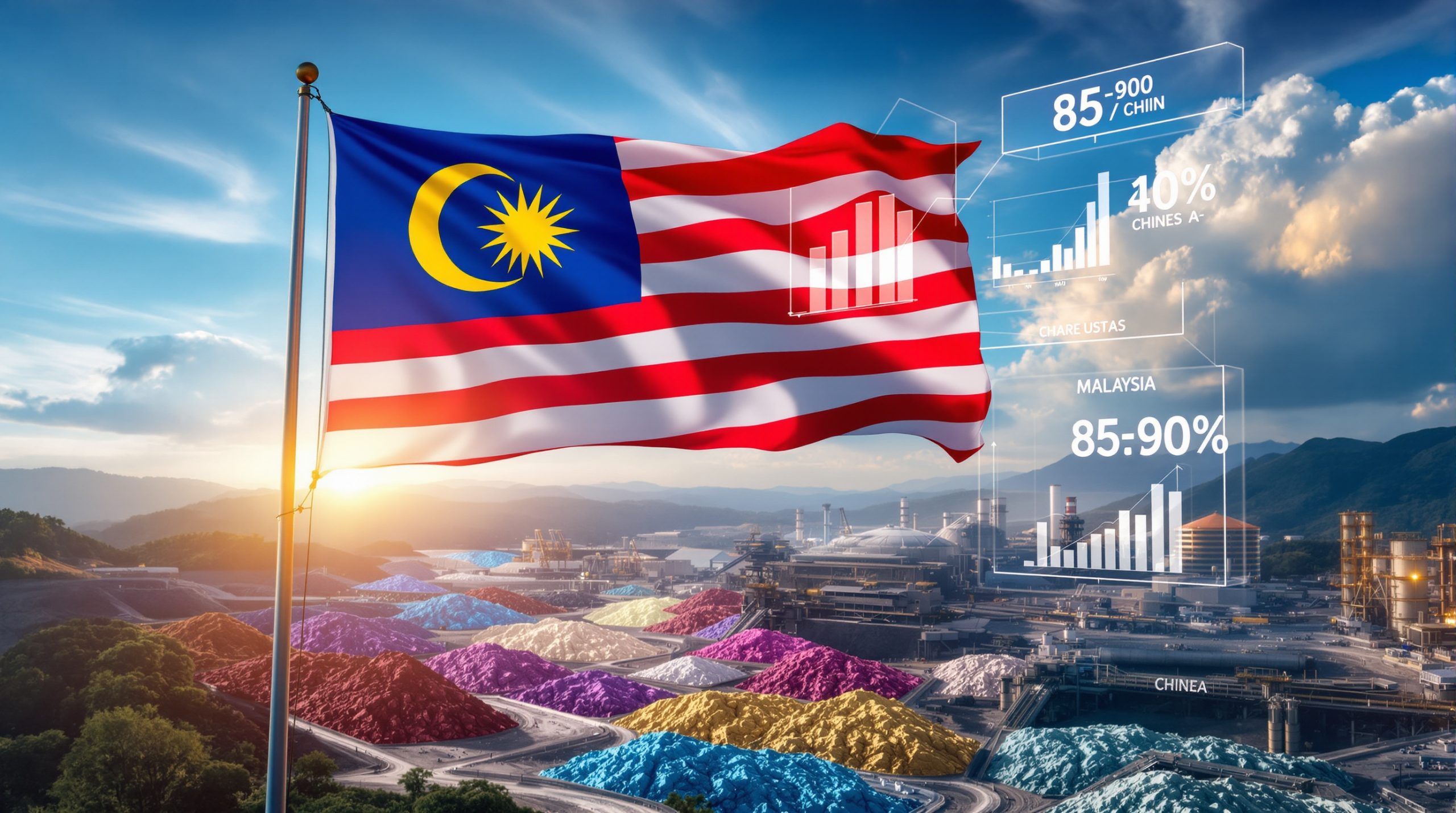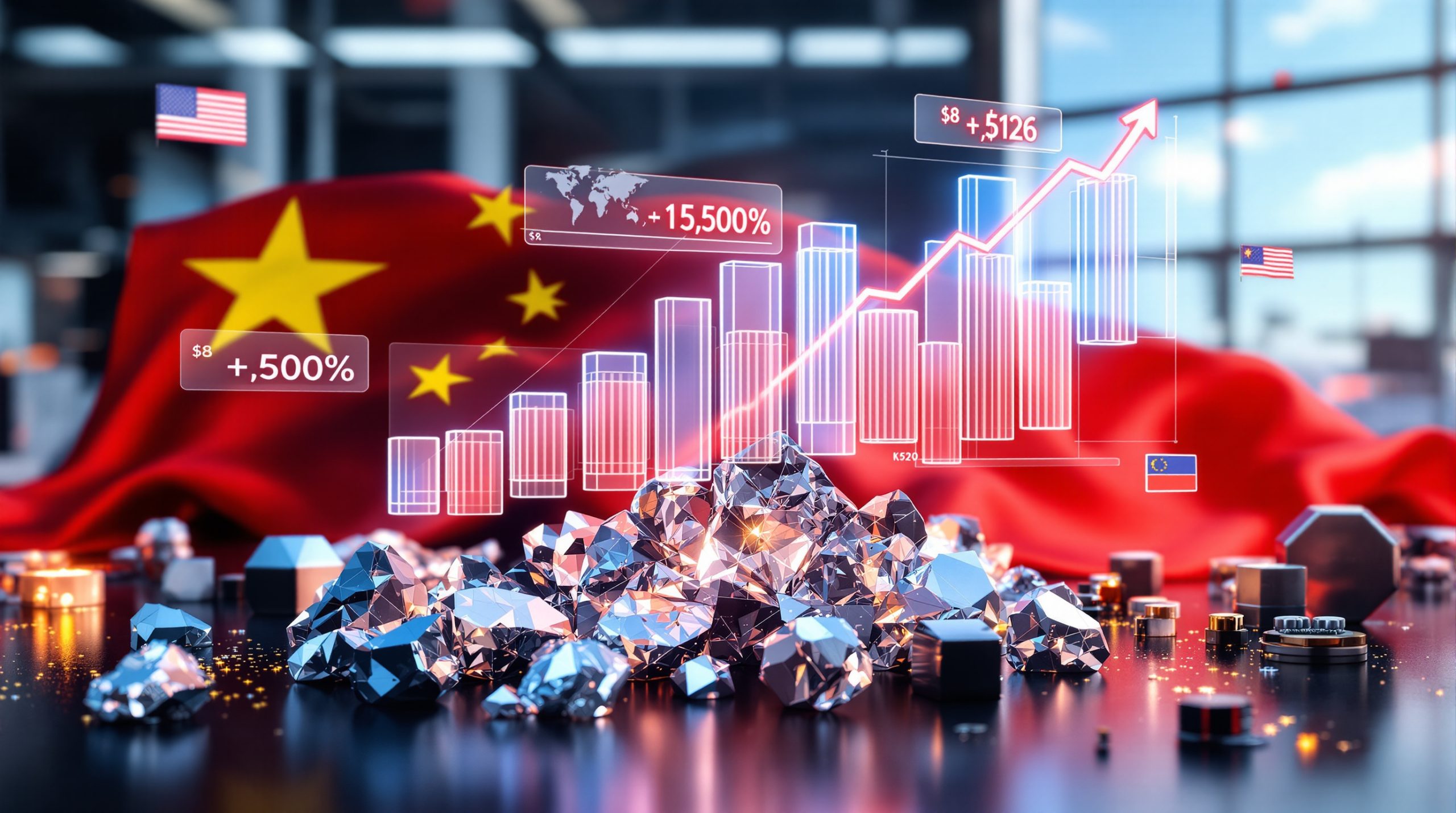How Are China's Rare Earth Restrictions Impacting Global Technology?
China's new export controls on rare earth materials have sent shockwaves through the global semiconductor industry, threatening to disrupt critical supply chains that power everything from smartphones to AI systems. These unprecedented restrictions require foreign companies to obtain licenses for products containing even trace amounts of Chinese rare earths, creating potential bottlenecks in the global technology ecosystem.
China controls approximately 70% of global rare earth mining and 85-90% of global rare earth processing capacity, giving it significant leverage over the technology supply chain. The October 2025 export controls represent what experts describe as the "strictest export controls that China has utilized," demonstrating Beijing's willingness to use its mineral dominance as a geopolitical tool.
The Strategic Importance of Rare Earth Elements
Rare earth elements are critical components in advanced technology manufacturing, particularly for semiconductors and electronics. Despite their name, these elements are relatively abundant in the Earth's crust but are difficult and environmentally challenging to extract and process in commercially viable quantities.
Rare earth ore typically contains only 2-10% rare earth oxides, requiring extensive chemical processing that generates significant toxic waste. China's willingness to accept these environmental costs has been a key factor in its processing dominance over the past decades.
Key applications in semiconductor manufacturing include:
- Neodymium (Nd) for high-strength permanent magnets used in precision manufacturing equipment
- Cerium oxide (CeO2) for achieving sub-nanometer surface roughness required for silicon wafer polishing
- Yttrium (Y) for yttrium aluminum garnet (YAG) lasers used in precision cutting and lithography
- Dysprosium (Dy) and Terbium (Tb) for improving high-temperature performance in manufacturing equipment
These elements are essential for chip fabrication equipment, including the machines that produce the world's most advanced semiconductors. The specialized magnets, lasers, and chemicals containing rare earths are critical components in the manufacturing processes that enable AI development and advanced computing.
What Makes China's New Export Controls Different?
China's latest export restrictions represent a significant escalation from previous trade measures, establishing what analysts describe as "long-arm jurisdiction" over foreign companies. This extraterritorial application of Chinese law extends regulatory authority beyond its borders to foreign entities in an unprecedented way.
Unprecedented Scope and Jurisdiction
The October 2025 export controls include several features that make them particularly disruptive:
- License requirements: Foreign firms must seek approval for shipping products containing even trace amounts of Chinese rare earths, regardless of processing location or quantity
- Explicit targeting: Regulations specifically mention components used in semiconductor manufacturing and AI research with military applications
- Global supply chain impact: Controls extend beyond direct exports to include re-export of products containing Chinese rare earths
- Processing timeline: The typical licensing review process for Chinese export controls ranges from 30-90 days, creating potential supply chain bottlenecks
These restrictions effectively grant China oversight of rare earth materials throughout the global supply chain, even after they leave Chinese borders. The requirement for foreign companies to seek Chinese approval for re-exporting products containing Chinese rare earths represents a significant expansion of China's regulatory reach.
Timeline of Escalating Tensions
| Date | Development |
|---|---|
| Early 2025 | Trump administration increases tariffs on Chinese imports |
| Spring 2025 | China cuts off mineral exports to US companies |
| Mid-2025 | Temporary trade truce reached between US and China |
| October 2025 | China announces comprehensive rare earth export controls |
| October 10, 2025 | Trump threatens 100% additional tariffs on Chinese goods |
This isn't the first time rare earths have been weaponized in trade disputes. In 2010, China temporarily halted rare earth exports to Japan during a diplomatic dispute over the Senkaku/Diaoyu Islands, causing rare earth oxide prices to spike by 300-700% within months. However, the current restrictions are more comprehensive and targeted specifically at semiconductor and AI technologies.
How Will Semiconductor Equipment Manufacturers Be Affected?
The semiconductor equipment industry faces particularly severe disruptions from China's export controls due to its heavy reliance on rare earth components in precision manufacturing systems.
ASML's Critical Position
ASML Holding NV, the only manufacturer of machines that produce the most advanced semiconductors, faces potentially significant disruptions. The company is the sole manufacturer of extreme ultraviolet (EUV) lithography systems, with each machine costing $150-200 million and containing approximately 100,000 parts from 5,000+ suppliers.
According to industry sources, ASML anticipates:
- Expected shipping delays: Weeks-long delays for critical equipment deliveries
- Re-export challenges: Particular concerns about requirements for approval of products containing Chinese rare earths
- Diplomatic response: Company actively lobbying Dutch and US allies for alternative solutions
Standard lead time for EUV systems already ranges from 12-18 months, with deep ultraviolet (DUV) systems requiring 6-12 months. Any additional delays could significantly impact global semiconductor production capacity expansion.
Impact on Broader Manufacturing Ecosystem
The restrictions threaten to create cascading effects throughout the semiconductor supply chain:
- Price increases: Rising costs for rare earth-dependent magnets critical to chip manufacturing
- Supply chain audits: Companies rushing to identify which products contain Chinese rare earths
- Processing bottlenecks: Concerns that licensing requirements will create significant delays
- Maintenance complications: Disruptions to spare parts containing rare earths could affect the existing installed base of equipment, not just new deliveries
Sintered NdFeB magnets used in semiconductor equipment typically require 29-32% neodymium content by weight, with additions of 1-6% dysprosium for high-temperature stability. Global production of these magnets was approximately 175,000 metric tons in 2023, with China producing over 90%.
What Are the Global Economic Implications?
The global semiconductor industry's heavy dependence on specialized equipment and materials creates significant vulnerabilities to supply chain disruptions.
Semiconductor Industry Vulnerabilities
The semiconductor industry generated $527 billion in revenue in 2023, with projections reaching $600+ billion by 2025. This industry forms the foundation of the digital economy, with each dollar of semiconductor sales supporting approximately $2.40 in economic output across other industries.
Major chipmakers potentially affected include:
- TSMC (Taiwan Semiconductor Manufacturing Company): Operates 13 fabs globally with approximately 16 million 300mm wafer equivalents annual capacity
- Samsung Electronics: Semiconductor division revenue of $46 billion in 2023, with plans to invest $230 billion in fab expansion through 2030
- Intel Corporation: Revenue of $54.2 billion in 2023, with $25+ billion committed to new U.S. fab construction
Modern semiconductor manufacturing involves approximately 1,000-1,400 individual processing steps, requiring inputs from hundreds of suppliers across multiple countries. This complexity makes the industry particularly vulnerable to targeted supply chain disruptions.
International Responses to China's Controls
Countries around the world are scrambling to assess and respond to China's new export controls:
- United States: President Trump announced retaliatory measures including 100% additional tariffs and market investments on Chinese goods and new export controls on "critical software"
- Germany: Expressed "great concern" about the restrictions and is working with the European Commission on a coordinated response
- Taiwan: Conducting assessments of potential impacts on its semiconductor industry while monitoring raw material price fluctuations
The U.S. House Select Committee on China described the restrictions as an "economic declaration of war against the US," with Committee Chairman John Moolenaar stating that China has "fired a loaded gun at the American economy." The fallout from China's rare earth curbs has intensified US‑China trade impacts on global supply chains.
Can Alternative Supply Chains Be Developed?
The restrictions are accelerating global efforts to develop alternative rare earth supply chains outside of China.
Diversification Efforts
Current rare earth production outside China includes:
- United States: Mountain Pass mine in California produced approximately 43,000 metric tons of rare earth ore in 2023
- Australia: Total rare earth production of approximately 18,000-20,000 metric tons in 2023, primarily from Lynas Rare Earths' Mt Weld operation
- Myanmar: Estimated 25,000-35,000 metric tons of rare earth concentrate exported to China in 2023
However, China still controls approximately 85% of global rare earth processing capacity. Lynas Rare Earths operates the only significant rare earth processing facility outside China, processing approximately 10,500 metric tons per year of rare earth products at its Malaysian plant.
Establishing new supply chains requires years of development and significant investment. Developing new mines and processing facilities typically takes 5-10 years from discovery to production, meaning significant non-Chinese capacity might not be available until the early 2030s.
Technical Alternatives
Researchers and companies are exploring ways to reduce dependence on rare earth elements:
- Material substitution: Research into non-rare-earth permanent magnets includes iron-nitride (Fe-N) and manganese-based compounds
- Recycling initiatives: Extracting rare earths from electronic waste and manufacturing byproducts
- Design innovations: Creating components that require fewer or no rare earth elements
The U.S. Department of Energy has funded multiple research programs totaling over $50 million since 2020 to develop rare-earth-free magnets, though none currently match NdFeB performance.
What Are the Geopolitical Ramifications?
The rare earth restrictions have further strained already tense relations between the world's two largest economies.
US-China Relations
The dispute highlights fundamental tensions in the global trading system:
- "Economic declaration of war": U.S. House Select Committee on China described the restrictions in these terms
- Canceled diplomacy: Trump threatened to cancel planned meeting with Chinese President Xi Jinping
- Escalating tariffs: US announced plans to raise import taxes on many Chinese goods to 130%
Trump's minerals order announced tariffs would raise import taxes on many Chinese goods to 130% starting next month, just below the 145% level imposed earlier in 2025, before both countries reduced levies in a temporary trade truce. According to Reuters, China's commerce ministry stated these export controls were designed to "safeguard national security and interests."
Global Trade Architecture
The dispute highlights several structural tensions in the global trading system:
- Resource nationalism: Countries increasingly viewing critical minerals as strategic assets
- Supply chain security: Nations prioritizing control over key technological inputs
- Trade agreement effectiveness: Questions about WTO's ability to manage technology-related trade disputes
Export restrictions on raw materials have been challenged under World Trade Organization rules. In 2014, China lost a WTO dispute regarding export quotas on rare earths, tungsten, and molybdenum, but the current measures are more sophisticated and harder to challenge under existing trade rules.
FAQ: Understanding China's Rare Earth Export Controls
What specific rare earth elements are most critical to semiconductor manufacturing?
Neodymium, dysprosium, and terbium are particularly important for creating the powerful magnets used in semiconductor manufacturing equipment. Cerium compounds are used in precision polishing of silicon wafers, while yttrium is essential for certain lasers used in chip production.
How long could it take for countries to develop alternative rare earth supply chains?
Developing new mines and processing facilities typically takes 5-10 years from discovery to production. While some projects are already underway in Australia, Canada, and the United States, achieving significant production volumes outside China could take until the early 2030s.
Will consumer electronics prices increase as a result of these restrictions?
Rare earth materials typically represent less than 1% of total bill-of-materials cost in consumer electronics, but supply chain disruptions can cause disproportionate impacts through manufacturing delays. The impact would likely be most significant for high-performance computing products and specialized industrial equipment.
How are semiconductor companies preparing for potential supply disruptions?
Major semiconductor manufacturers are implementing multiple strategies, including:
- Building inventory of critical components where possible
- Auditing supply chains to identify exposure to Chinese rare earths
- Exploring alternative material sources and technologies
- Engaging with governments to develop coordinated responses
The Future of Global Rare Earth Supply Chains
The current crisis has highlighted the vulnerability of global technology supply chains to geopolitical tensions. As countries and companies respond to China's export controls, several key trends are likely to emerge:
- Accelerated investment in rare earth mining and processing outside China
- Strategic stockpiling of critical materials by governments and companies
- Increased vertical integration as technology companies seek to secure supply chains
- Innovation in material science to reduce dependence on geopolitically vulnerable resources
Japan established a national rare earth stockpiling program after the 2010 export restrictions, maintaining minimum 60-day reserves of critical rare earths. The United States National Defense Stockpile holds limited quantities of rare earth materials deemed strategic, but these reserves are insufficient for commercial semiconductor production.
The semiconductor industry faces a period of adjustment as it navigates these new challenges. While short-term disruptions are likely, the long-term response may ultimately create more resilient and diversified global supply chains for these critical materials. According to Rare Earth Exchanges, "These export controls represent a major geopolitical power play that could reshape global supply chains for decades."
Countries worldwide are now accelerating efforts to secure green transition raw materials and strengthen critical minerals energy security as the fallout from China's rare earth curbs continues to reverberate through global technology markets.
Disclaimer: This article contains forecasts and speculation about future market developments and geopolitical events. These predictions are based on current information and expert analysis but are subject to change as the situation evolves. Readers should consider multiple sources and perspectives when making business or investment decisions related to the topics discussed.
Want to Discover the Next Major Mineral Play Before the Market?
Stay ahead of critical mineral supply disruptions with Discovery Alert's proprietary Discovery IQ model, delivering instant notifications on significant ASX mineral discoveries that could reshape global supply chains. Explore how historic discoveries have generated substantial returns by visiting the Discovery Alert discoveries page and begin your 30-day free trial today.




